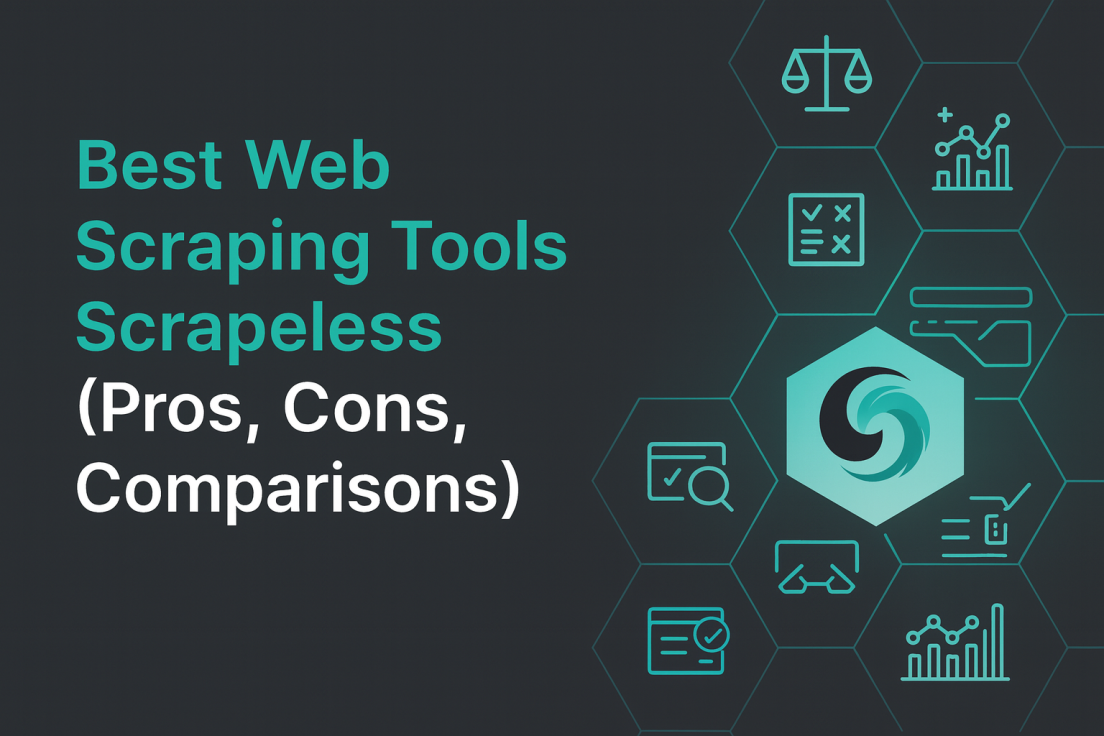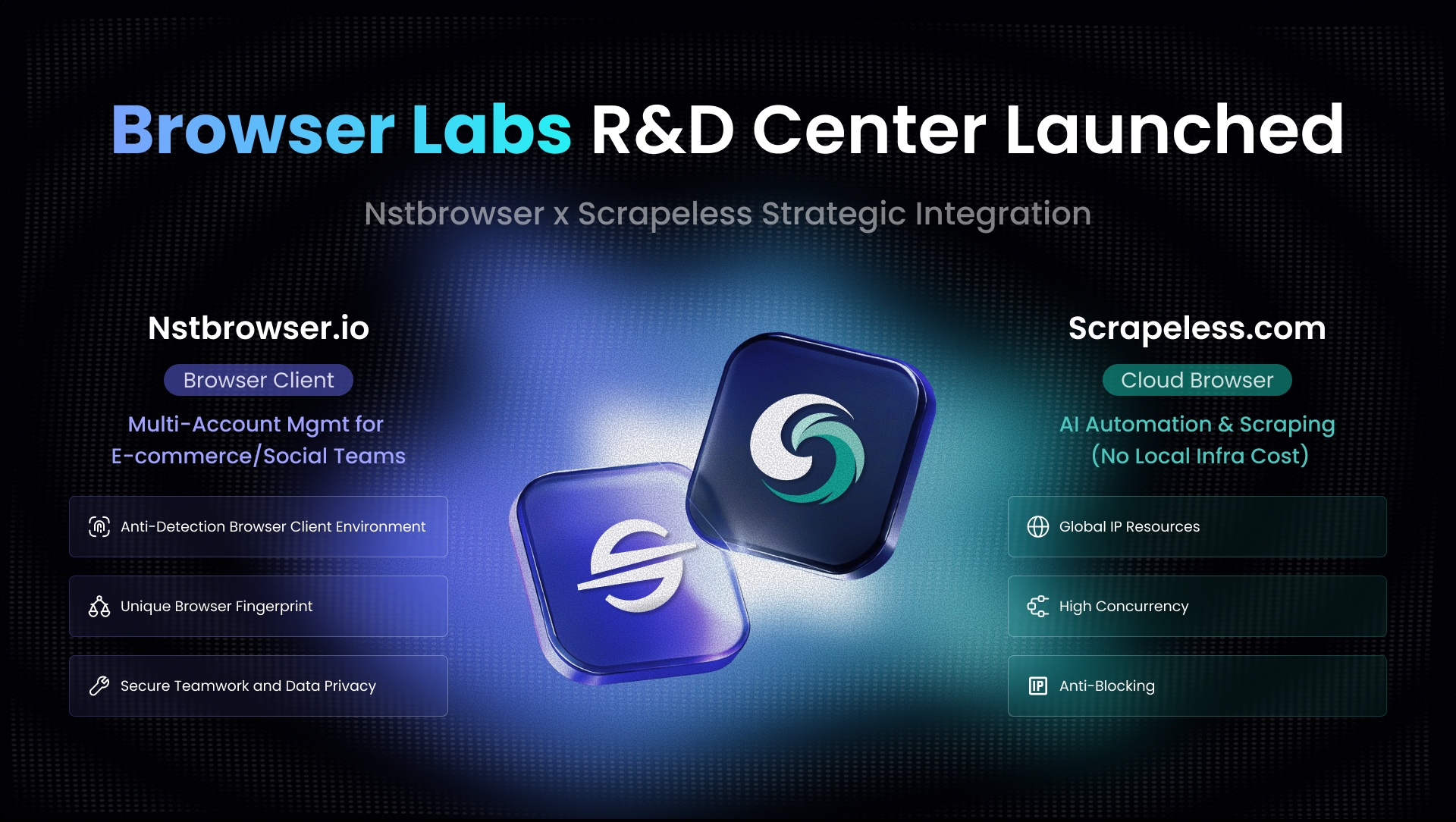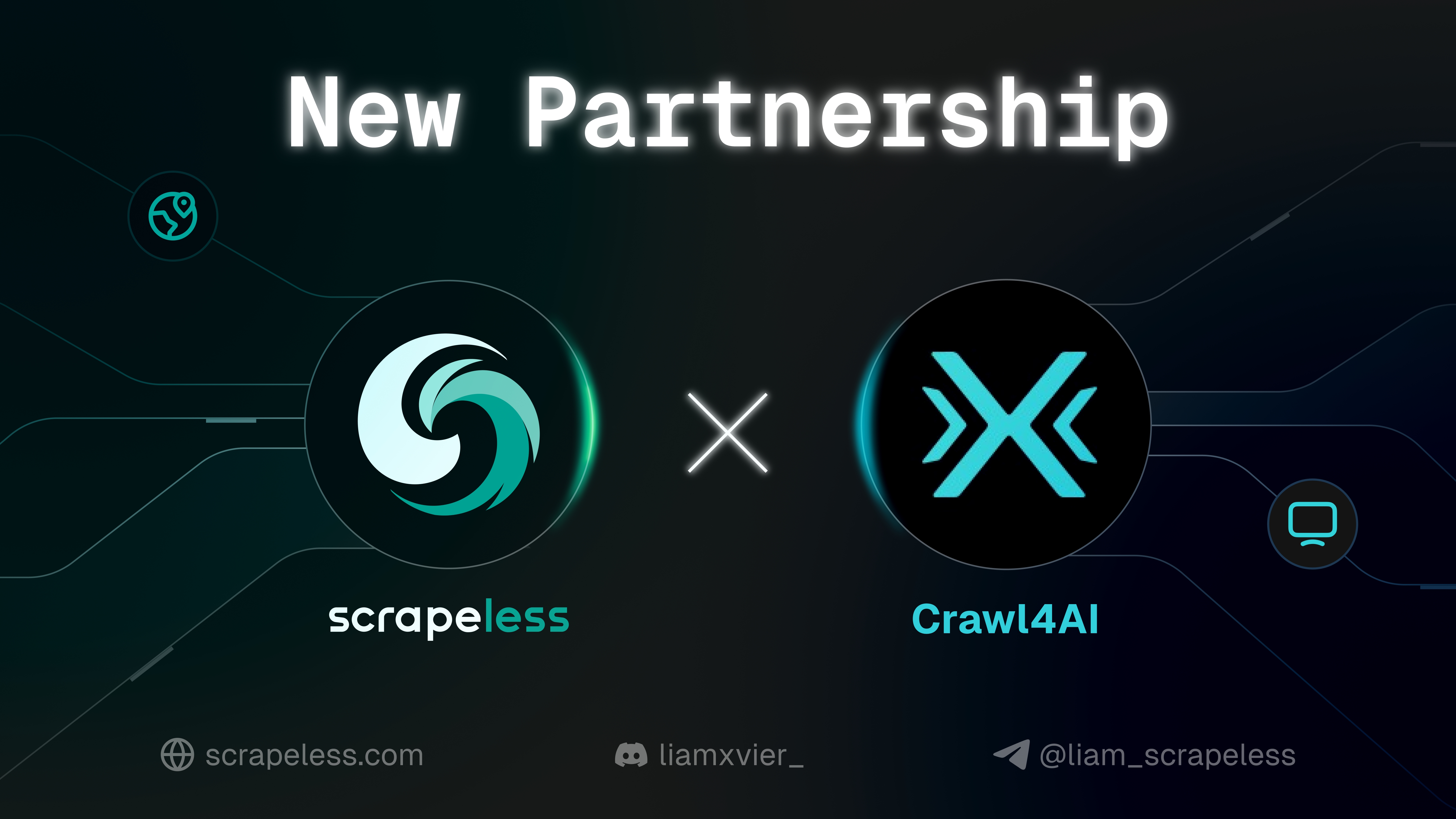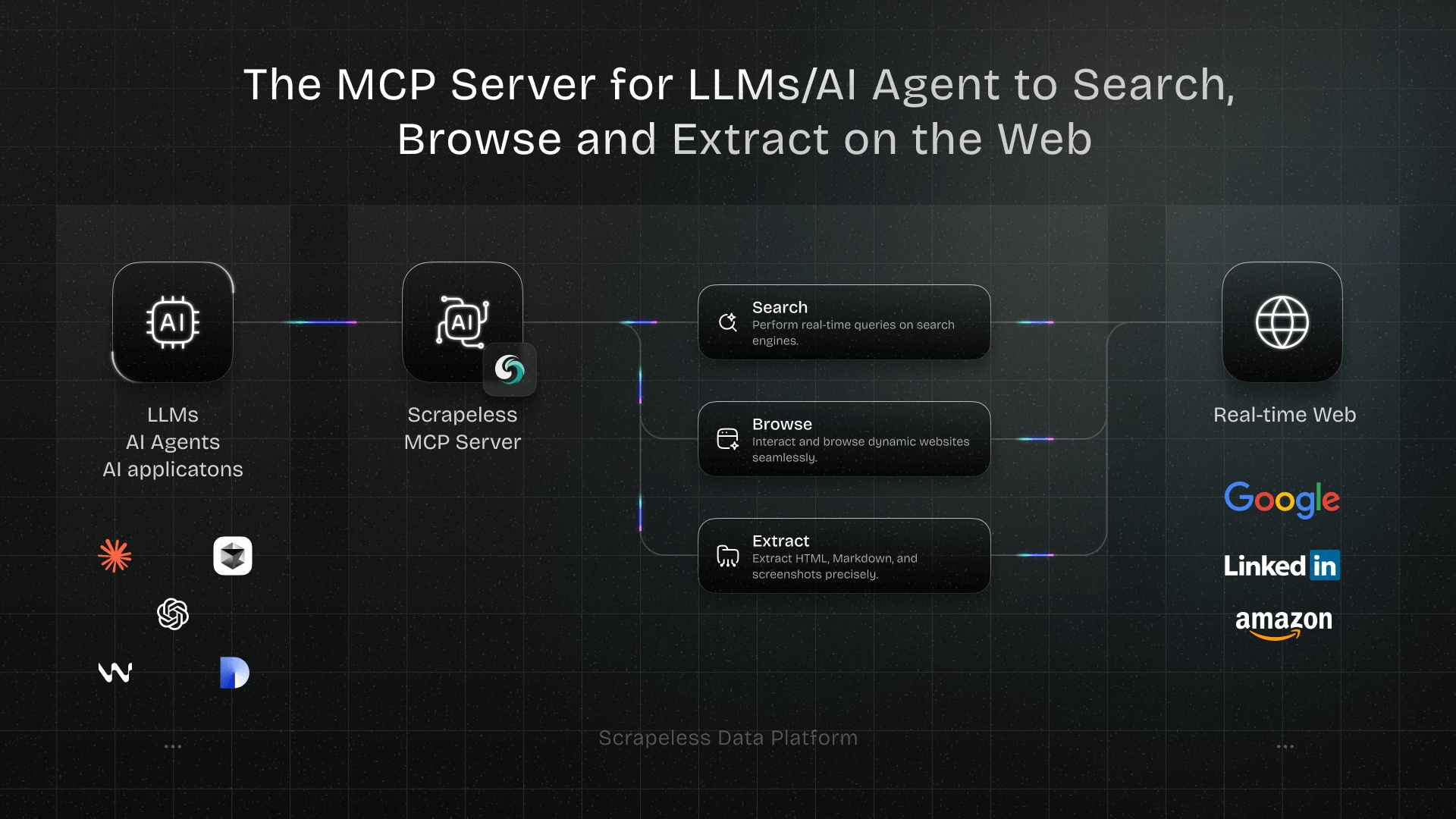Best Web Scraping Tools: Scrapeless Review, Pros, Cons & Comparisons
Expert Network Defense Engineer
Key Takeaways:
- Scrapeless is a powerful web scraping API that simplifies data extraction by handling proxies, CAPTCHAs, and browser fingerprinting.
- It offers a suite of tools including a Scraping API, Scraping Browser, and Deep SERP API for various scraping needs.
- Key advantages of Scrapeless include its ease of use, high success rate, and robust features for bypassing anti-bot measures.
- Potential drawbacks include the cost for high-volume scraping and reliance on a third-party service.
- When compared to competitors like ScraperAPI, Bright Data, and Octoparse, Scrapeless stands out for its comprehensive feature set and developer-friendly approach.
Introduction
In the data-driven landscape of 2025, web scraping is indispensable for businesses, researchers, and developers. Extracting and analyzing web data provides a significant competitive advantage. However, challenges like anti-bot measures, CAPTCHAs, IP blocks, and dynamic content complicate the process. Among leading web scraping tools, Scrapeless stands out. This article comprehensively reviews Scrapeless, detailing its pros, cons, and comparing it with other top tools to guide your data extraction decisions.
What is Scrapeless?
Scrapeless is a cutting-edge web scraping API and platform designed to simplify and optimize internet data extraction. It intelligently mediates between your application and target websites, automatically handling complex scraping challenges. Scrapeless provides reliable, scalable, and efficient data extraction by bypassing anti-bot measures, managing proxies, and rendering dynamic content.
Unlike traditional methods requiring intricate infrastructure for proxy rotation, User-Agent management, and headless browser control, Scrapeless offers these as a service. This allows users to focus on data analysis rather than acquisition technicalities. Scrapeless is ideal for websites with advanced anti-bot protections, JavaScript-heavy content, and frequent CAPTCHAs or rate limits.
Core Offerings of Scrapeless:
Scrapeless provides a suite of tools tailored to different web scraping needs:
- Scraping API: The flagship product. Send a target URL; Scrapeless fetches the page, bypasses anti-bots, and returns raw HTML or structured data. Supports JavaScript rendering, geo-targeting, and custom headers.
- Scraping Browser: For complex interactions or full browser emulation. Users control a remote browser instance to execute JavaScript, click elements, and fill forms, while Scrapeless manages infrastructure and anti-detection.
- Deep SERP API: Specialized for search engine results page (SERP) scraping. Provides structured data from Google, Bing, etc., handling SERP nuances and anti-bot challenges for clean, parseable results.
- Captcha Solver: Integrated into other services, it automatically detects and solves various CAPTCHA types (e.g., reCAPTCHA, hCaptcha), ensuring uninterrupted scraping.
Scrapeless positions itself as a comprehensive solution for overcoming modern web scraping hurdles, offering high success rates and reduced operational overhead.
Pros of Scrapeless
Scrapeless offers compelling advantages, making it a top contender for efficient, reliable, and easy data extraction.
1. High Success Rate Against Anti-Bot Measures
Scrapeless excels at bypassing sophisticated anti-bot systems like Cloudflare, reCAPTCHA, and hCaptcha. It uses:
- Intelligent Proxy Network: A vast, diverse pool of automatically rotated residential and mobile IPs, making IP-based blocking ineffective.
- Advanced Browser Fingerprinting: Mimics real browser fingerprints (User-Agent rotation, realistic HTTP headers) to make automated requests indistinguishable from human browsing.
- JavaScript Rendering: Fully renders JavaScript-heavy pages, ensuring all dynamic content is accessible, crucial for modern web scraping.
- Automated CAPTCHA Solving: Automatically detects and solves CAPTCHAs, eliminating a major bottleneck.
This high success rate ensures reliable data collection and reduces troubleshooting time.
2. Simplified Integration and Ease of Use
Designed for developer convenience, Scrapeless uses an API-first approach for straightforward integration. Robust data extraction is achieved with simple HTTP requests, eliminating the need to build and maintain complex scraping infrastructure.
- Single API Endpoint: Most features are accessible via one well-documented API endpoint.
- Reduced Development Time: Developers save time on anti-bot evasion, proxy management, and browser automation setup, focusing instead on data parsing and utilization.
- No Infrastructure Management: Scrapeless handles server maintenance, scaling, and headless browser management, providing a fully managed service.
3. Scalability and Performance
Built for enterprise-grade data extraction, Scrapeless offers impressive scalability and performance for high-volume requests.
- Distributed Architecture: Cloud-based architecture ensures efficient, reliable processing under heavy load.
- Optimized Request Throttling: Intelligently manages request rates to avoid triggering website rate limits, ensuring optimal speed without detection.
- Global Infrastructure: A global network of proxies and servers supports geo-targeted scraping.
4. Comprehensive Feature Set
Beyond basic scraping, Scrapeless provides a rich set of features:
- Scraping Browser: Full browser control for complex interactions.
- Deep SERP API: Specialized for structured search engine results.
- Customizable Options: Allows custom headers, cookies, JavaScript execution, and waiting for specific elements.
- Real-time Data: Delivers real-time data for dynamic markets.
5. Focus on Data, Not Infrastructure
Scrapeless allows businesses and developers to shift focus from operational scraping challenges to the strategic value of data. By offloading anti-bot evasion and infrastructure management, users can dedicate resources to data analysis, integration, and decision-making, leading to faster insights and efficient operations.
Cons of Scrapeless
Considering potential drawbacks is important for determining if Scrapeless suits your needs.
1. Cost for High-Volume Scraping
As a premium, usage-based service, Scrapeless can be costly for extremely high-volume operations. While it abstracts infrastructure and anti-bot complexities, the cumulative cost might exceed a meticulously self-managed solution if you have in-house expertise. However, factoring in hidden costs (developer time, proxy subscriptions, maintenance) often makes Scrapeless more economical long-term.
2. Reliance on a Third-Party Service
Using a third-party API means reliance on the provider for uptime, performance, and feature development. Any outage or API change could impact operations. This is a trade-off for convenience and power, but a factor for mission-critical applications requiring absolute control.
3. Less Granular Control for Niche Cases
Scrapeless handles most scraping scenarios efficiently. However, for extremely niche tasks requiring very specific, low-level browser interactions or unique network configurations, a self-managed headless browser setup might offer more granular control. This is rare, as Scrapeless continuously expands customization.
4. Learning Curve for Advanced Features
Basic Scrapeless usage is straightforward, but advanced features (complex JavaScript execution, Deep SERP API integration) still require understanding web technologies and API interactions. For absolute beginners, no-code visual tools might seem simpler, but they lack Scrapeless's power and flexibility for complex projects.
In summary, Scrapeless's cons are largely a function of its pros; its power and convenience come with a cost and abstraction. For most professional web scraping needs, offloading complexity outweighs these considerations.
Scrapeless vs. Other Leading Web Scraping Tools
Comparing Scrapeless with other prominent tools highlights its value proposition and where it excels.
1. Scrapeless vs. ScraperAPI
ScraperAPI is a direct competitor, also offering API-based solutions for proxies, CAPTCHAs, and JavaScript rendering.
- Similarities: Both simplify scraping by abstracting complexities.
- Differences: Scrapeless often provides a more comprehensive suite, including a dedicated Scraping Browser and specialized Deep SERP API. Its integrated CAPTCHA solving and advanced browser fingerprinting might give it an edge on challenging sites, often requiring less configuration than ScraperAPI.
2. Scrapeless vs. Bright Data
Bright Data offers extensive proxy networks and a Web Unlocker product that competes with Scrapeless.
- Similarities: Both bypass anti-bot measures and access web data.
- Differences: Bright Data excels in its granular proxy network control. Scrapeless integrates proxies more seamlessly into its API, requiring less user configuration. Bright Data can be complex for beginners, while Scrapeless aims for a streamlined, developer-friendly experience.
3. Scrapeless vs. Octoparse (No-Code Tools)
Octoparse represents no-code visual web scraping tools.
- Similarities: Both aim to simplify web data extraction.
- Differences: Octoparse is ideal for beginners on simple websites but struggles with dynamic content, complex anti-bot measures, and large-scale scraping. Scrapeless, API-driven, requires coding but offers greater flexibility, scalability, and robustness against advanced anti-bot techniques.
4. Scrapeless vs. Self-Built Solutions (e.g., Python with Scrapy/Selenium)
Self-built solutions offer maximum control but are resource-intensive.
- Similarities: Self-built solutions offer maximum control and can be tailored precisely to specific needs.
- Differences: Building and maintaining a robust self-built scraper is resource-intensive (development, maintenance, proxy updates, troubleshooting). Scrapeless eliminates this overhead by providing a managed service. While direct API costs might be lower for small projects, the total cost of ownership for complex projects is often higher with self-built solutions.
Comparison Table: Scrapeless and Alternatives
| Feature/Tool | Scrapeless | ScraperAPI | Bright Data (Web Unlocker) | Octoparse (No-Code) | Self-Built (Scrapy/Selenium) |
|---|---|---|---|---|---|
| Type | Web Scraping API/Platform | Web Scraping API | Proxy Network + Web Unlocker | No-Code Visual Scraper | Custom Code (Libraries) |
| Anti-Bot Bypass | Excellent (AI-driven, integrated CAPTCHA) | Very Good (Proxies, JS rendering, CAPTCHA) | Excellent (Extensive proxies, Web Unlocker) | Limited (Struggles with complex sites) | High (Requires significant effort) |
| JS Rendering | Yes | Yes | Yes | Limited (Browser-based) | Yes (via headless browsers) |
| Proxy Management | Automated (Residential, Mobile, Datacenter) | Automated (Datacenter, Residential) | Manual/Automated (Extensive options) | N/A (Uses internal proxies) | Manual (Requires external providers) |
| Ease of Use | High (Simple API calls) | High (Simple API calls) | Medium (More configuration) | Very High (Visual interface) | Low (Requires coding expertise) |
| Scalability | Excellent | Excellent | Excellent | Medium (Can be slow for large tasks) | Variable (Depends on implementation) |
| Cost | Medium to High (Usage-based) | Medium to High (Usage-based) | High (Usage-based, extensive options) | Low to Medium (Subscription) | Variable (Hidden costs often high) |
| Control | Good (Custom headers, JS execution) | Good | Very High (Proxy granularity) | Low (Limited customization) | Very High (Full customization) |
| Best For | Reliable, scalable scraping of complex sites with minimal effort | General-purpose API scraping, good for many sites | Large-scale, highly customized proxy needs, granular control | Simple, small-scale projects for non-coders | Highly unique, niche requirements with dedicated resources |
Conclusion and Call to Action
Choosing the right web scraping tool is crucial for efficient data extraction. Scrapeless offers a powerful, all-in-one solution that excels at bypassing anti-bot measures, rendering JavaScript, and managing proxies, making it ideal for complex and large-scale projects. Its API-first approach simplifies integration, allowing developers to focus on data analysis rather than infrastructure management.
While other tools like ScraperAPI, Bright Data, no-code solutions, and self-built frameworks have their merits, Scrapeless often provides a superior balance of power, ease of use, and reliability for modern web scraping challenges. Its comprehensive feature set and focus on anti-detection make it a strong contender for anyone serious about web data.
Ready to streamline your web scraping and overcome anti-bot challenges?
Explore the capabilities of Scrapeless and experience effortless data extraction. Visit our website to learn more and start your free trial today!
Start Your Free Trial with Scrapeless Now!
Frequently Asked Questions (FAQ)
Q1: What makes Scrapeless different from other web scraping APIs?
Scrapeless differentiates itself through its comprehensive, integrated approach to anti-bot evasion, including AI-driven browser fingerprinting, automated CAPTCHA solving, and a robust proxy network. It offers a broader suite of tools (Scraping API, Scraping Browser, Deep SERP API) designed for high success rates on complex, dynamic websites with minimal user configuration.
Q2: Is Scrapeless suitable for beginners?
While Scrapeless is API-driven and requires some coding knowledge, its simplified integration makes it accessible to developers. For absolute beginners with no coding experience, visual no-code tools might be simpler initially, but Scrapeless offers far greater power and reliability for serious projects.
Q3: Can Scrapeless handle JavaScript-heavy websites?
Yes, Scrapeless is specifically designed to handle JavaScript-heavy websites. Its advanced JavaScript rendering capabilities ensure that all dynamic content is fully loaded and accessible for scraping, overcoming a common challenge for many traditional scrapers.
Q4: How does Scrapeless manage proxies?
Scrapeless manages a vast, intelligent proxy network (including residential, mobile, and datacenter IPs) automatically. It handles rotation, selection, and health checks behind the scenes, ensuring optimal performance and anti-detection without requiring manual configuration from the user.
Q5: What kind of data can I extract with Scrapeless?
Scrapeless can extract virtually any publicly available data from websites, including product information, pricing, reviews, news articles, search engine results, social media data, and more. Its flexibility allows for both raw HTML extraction and structured data delivery, depending on your needs.
References
[1] How to Avoid Bot Detection When Web Scraping
[2] Headless Browser Scraping: A Comprehensive Guide
[3] Web Scraping Proxy: The Ultimate Guide
[4] CAPTCHA Solver Upgrade: Enhanced Bypass Capabilities
[5] Deep SERP API: Advanced Search Engine Data Extraction
At Scrapeless, we only access publicly available data while strictly complying with applicable laws, regulations, and website privacy policies. The content in this blog is for demonstration purposes only and does not involve any illegal or infringing activities. We make no guarantees and disclaim all liability for the use of information from this blog or third-party links. Before engaging in any scraping activities, consult your legal advisor and review the target website's terms of service or obtain the necessary permissions.



